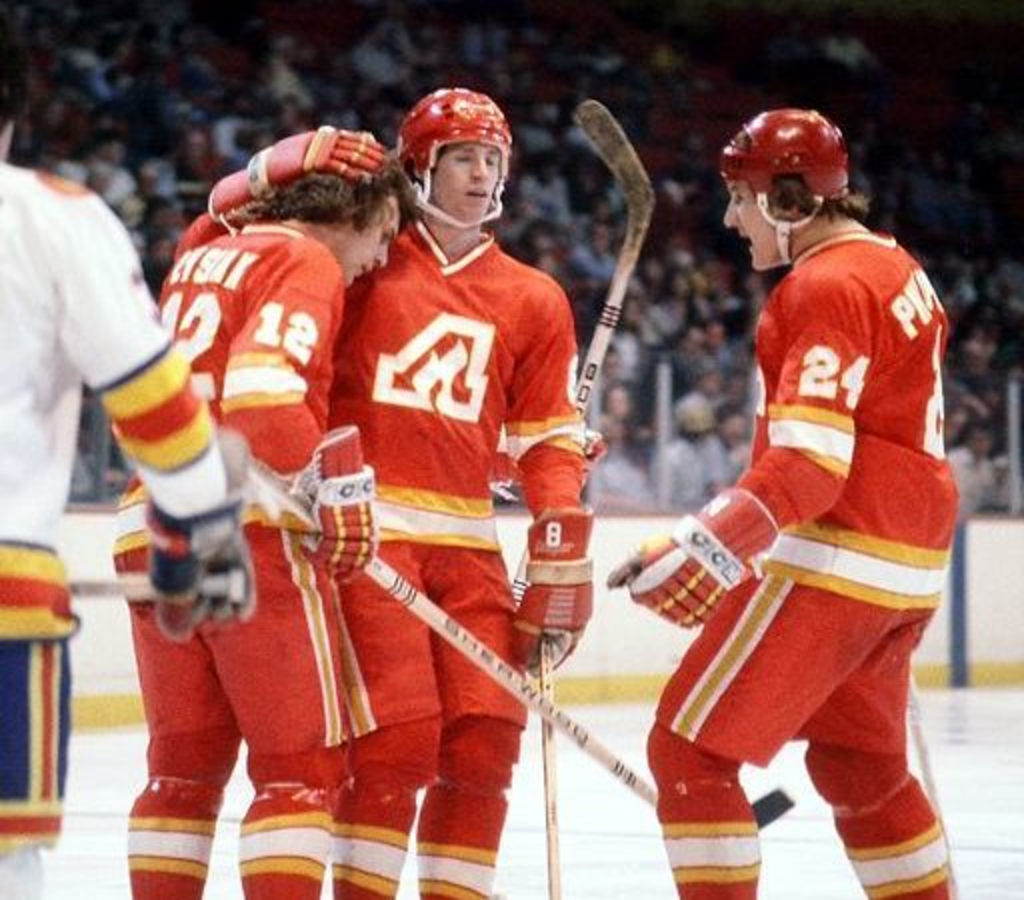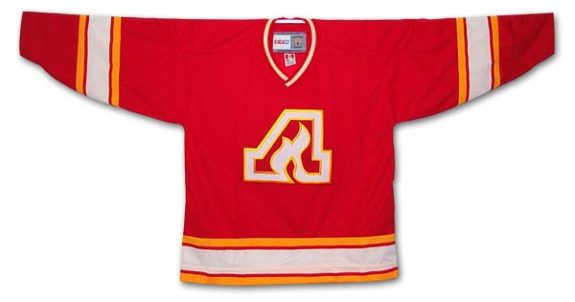The ’12 Days of Christmas’ is a classic holiday song first published in its current form in 1908. In a nod to the classic carol, join The Hockey Writers as we count down the 12 Days of Hockeymas. Each day, we will provide you with a piece of hockey history as we eagerly await the start of the 2020-21 NHL season.

The Atlanta Flames were born prematurely, and the team never really found their footing in a league that was constantly looking over its shoulder at the upstart World Hockey Association. The NHL had recently grown from six teams in 1966 to fourteen by 1970 and had no further plans to expand until at least 1973. That strategy was tossed out the window when the WHA announced it was launching a rival league in the fall of 1972, boldly promising to enter markets that already had an NHL franchise.
The NHL Was Boxed Into a Corner
Under pressure, the NHL felt it had to counterpunch, so it accelerated plans to be the first major pro hockey league to put a team in the American south. Hearing reports the WHA also had their sights on the new Nassau Coliseum in Long Island, the NHL knew they had to act fast. In November 1971, the NHL announced the addition of the Atlanta Flames and the New York Islanders who would join the league in time for the 1972-73 regular season.

Owner Tom Cousins paid $6 million to buy the franchise, and he named the team the ‘Flames’ in homage to the burning of Atlanta by U.S. forces during the American Civil War. The Flames hired Cliff Fletcher to serve as the team’s first general manager and the squad made Atlanta’s brand new Omni Coliseum its home, which seated 14,568.
After winning their first NHL game 3-2 against their expansion cousins, the Islanders, the Flames played well and made it past the halfway point of their inaugural season with a 20-19-8 record. That early success was short-lived, as the team only mustered five more wins the rest of the season, finishing 25-38-15 and second last in the West Division.
Flames Rookies Were Bright Spots in Those Early Years
The Flames selected Tom Lysiak second overall at the 1973 NHL Draft and the Calder Trophy finalist made an immediate impact in his rookie season. Lysiak led the team in scoring and carried the Flames to a 30-34-14 record and the franchise’s first playoff berth, a seven-game series against the Philadelphia Flyers. The Flames were no match for the Flyers and bowed out in four straight games.
The following season, newcomer Eric Vail led the Flames with 39 goals and won the Calder Trophy as the NHL’s top rookie, while second-year forward Lysiak repeated as the team’s top scorer with 77 points. Together, the pair helped the Flames to their first winning season at 34-31-15, but with the NHL’s expansion to 18 teams, their record was only good enough for fourth place in the new Patrick Division and Atlanta found themselves out of the playoffs again.

With Better Teams Came More Playoff Misery
By 1975, the Flames were no longer a fresh-faced expansion team but they were far from Stanley Cup contenders. Over the next three seasons, the team’s record was barely above .500 but, to their credit, they were playing a consistent brand of hockey that earned them three straight third-place finishes in the Patrick Division and a return to the NHL postseason.
The Flames could not get over the hump and continued to lose in the preliminary round. In the 1976 Playoffs, the Los Angeles Kings bounced them two games to none in their best-of-three series. The following season, the Flames made franchise history by finally winning a playoff game but they fell to the Kings again in the deciding Game 3. Another deflating playoff sweep at the hands of the Detroit Red Wings in the 1978 Playoffs had Fletcher wondering what the team had to do to find postseason success:
“We always found a way to lose in the playoffs,” Fletcher said. “The opening round was best-of-three for four or five years there. We found strange ways to lose to Detroit and Los Angeles. We were struggling on defence because we used first-round picks in the mid-1970s to take defensemen that never played up to the level we expected,”
from ‘Former Flames recall hot times in Atlanta” – John McGourty – NHL.com – 01/24/2008
No Shortage of Skilled Players on the Flames Roster in the Late 1970s
Despite the team’s struggles on defence, they had no trouble putting the puck in the net and putting on a great show while they were at it. The Flames kept churning out outstanding rookies and the organization saw its second Calder Trophy-winner in just three years when 1975 pick Willi Plett took home the hardware after scoring 33 goals in the 1976-77 season.
The Flames had plenty of firepower on the roster with skilled players like Bob MacMillan, Lysiak, Vail, Ken Houston and Plett. But it was Guy Chouinard who made franchise history by becoming the first Flame to score both 100 points and 50 goals in a season.
An explosion of offence in the 1978-79 season saw the team post its best record in their Atlanta years at 41-31-8, but their postseason struggles continued. This time, the Flames suffered a disappointing sweep in a five-game series against the Toronto Maple Leafs.
The 1979-80 Season Marked the Beginning of the End
Meanwhile, the NHL’s decade-long battle with the WHA was finally over. The struggling, upstart league dissolved in June 1979 and the National Hockey League absorbed four of its strongest franchises. The Flames benefitted by picking up former WHA star Kent Nilsson, who led his new team in scoring with 40 goals but could not make any headway in the postseason. After a mediocre 35-32-13 regular season, the Flames faced off against the New York Rangers in a best-of-five series in April 1980.
After losing the first two games in New York, the Flames won only their second playoff game in franchise history, beating the Rangers 4-2 at home in Game 3. On April 12, 1980, the Flames suited up for their final game in Atlanta, a 5-2 loss that eliminated them from the playoffs and unceremoniously closed the book on the organization’s time in Georgia.
Over eight middling seasons, the Flames played 636 regular season games, winning 268, losing 260 and tying 108. While the team qualified for the playoffs six of the eight years they played in Atlanta, they only managed two victories and failed to capture the imagination of local sports fans.
Attendance at the Omni Coliseum peaked at an average of 14,161 fans per game in their second season, but by the 1979-80 season, that had fallen to just 10,024. It is estimated that Cousins lost $12 million during his eight years as owner and on May 21, 1980, he announced the sale of the Flames to a consortium of Calgary businessmen for $16 million, which was the highest price ever paid for an NHL franchise.
Atlanta’s Legacy Lives on in Calgary
The Calgary ownership group purchased an underachieving team that was primed for success. Ironically, a franchise that had only won two total playoff games in its entire history immediately won two playoff rounds when it moved 3,728 km north. In the 1981 Playoffs, the reincarnated Calgary Flames swept the Chicago Blackhawks, beat the Philadelphia Flyers in seven games, and ultimately lost to the Minnesota Northstars in the semi-finals four games to two. The Flames’ first decade in Calgary saw multiple deep playoff runs, including a Stanley Cup Final appearance in 1986 and the team’s only Cup win in 1989.

None of this success would have been possible without the initial franchise joining the NHL over 48 years ago. While the Flames’ time in Atlanta won’t be remembered for their on-ice triumphs, it has become a treasured part of the team’s rich history. For almost 25 years, the organization has used the Atlanta “Flaming A” logo to denote alternate captains and honour its connection to the ORIGINAL Flames – a team that made its mark in the hockey world from 1972 to 1980.